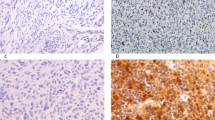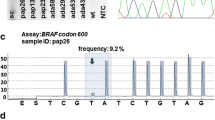Abstract
At present, no effective medical treatment exists for recurrent and aggressive craniopharyngiomas that are resistant to conventional therapies, including surgery and adjuvant radiotherapy. Temozolomide is an alkylating chemotherapeutic agent used routinely in the management of high grade gliomas. The response to temozolomide is suggested to be dependent on the tumoral expression of O-6 methylguanine DNA methyltransferase (MGMT). Evidence supports that low MGMT immunoexpression correlates with positive response to temozolomide. Therefore, we aimed to assess MGMT immunoexpression in adamantinomatous craniopharyngiomas, in an effort to predict the likelihood of response to temozolomide. The MGMT immunostaining was performed on 23 adamantinomatous craniofaryngiomas operated at the Sisli Etfal Training and Research Hospital and identified by histological analysis. Paraffin embedded tissue sections were immunostained for MGMT and were evaluated semi-quantitatively. Of the 23 cases evaluated, 22 (96%) demonstrated negative (<10%) and 1 (4%) demonstrated low (10%) MGMT immunoexpression. Data from this study suggest a high proportion of adamantinomatous craniopharyngiomas exhibit negative/low MGMT immunoreactivity and could be treated with temozolomide, if conventional therapy fails.

Similar content being viewed by others
References
Janzer RC, Burger PC, Giangaspero F, Paulus W (2000) Craniopharyngioma. In: Kleihues P, Cavenee WK (eds) World Health Organization classification of tumours of the central nervous system. IARC, Lyon, pp 244–246
Karavitaki N, Cudlip S, Adams C, Wass JAH (2006) Craniopharyngiomas. Endocr Rev 27(4):371–397
Barua KK, Ehara K, Kohmura E, Tamaki N (2003) Treatment of recurrent craniopharyngiomas. Kobe J Med Sci 49(5–6):123–132
Su YB, Sohn S, Krown SE, Livingston PE, Wolchok JD, Quinn C et al (2004) Selective CD4+ lymphopenia in melanoma patients treated with temozolomide: a toxicity with therapeutic implications. J Clin Oncol 22:610–616
Gerson SL (2004) MGMT: its role in cancer aetiology and cancer therapeutics. Nat Rev Cancer 4(4):296–307
Kovacs K, Horvath E, Syro LV, Uribe H, Penagos LC, Ortiz LD, Fadul CE (2007) Temozolomide therapy in a man with an aggressive prolactin-secreting pituitary neoplasm: morphological findings. Hum Pathol 38:185–189
Kovacs K, Scheithauer BD, Lombardero M, McLendon LE, Syro LV, Uribe H, Ortiz LD, Penagos LD (2008) MGMT immunoexpression predicts responsiveness of pituitary tumours to temozolomide therapy. Acta Neuropathol 115:261–262
Lau Q, Scheithauer B, Kovacs K, Hovarth E, Syro LV, Lloyd R (2010) MGMT immonoexpression in aggressive pituitary adenoma and carcinoma. Pituitary. doi:10.1007/s11102-010-0249-0
Sofietti R, Leoncini B, Ruda R (2007) New devlopments in the treatment of malignant gliomas. Expert Rev Neurother 7(10):1313–1326
Fadul CE, Kominsky AL, Meyer LP, Kingman LS, William B, Kinlaw WB et al (2006) Long-term response of pituitary carcinoma to temozolomide. Report of two cases. J Neurosurg 105:621–626
Takeshita A, Inoshita N, Taguchi M, Okuda C, Fukuhara N, Oyama K et al (2009) High incidence of low O6-methylguanine DNA methyltransferase expression in invasive macroadenomas of Cushing’s disease. Eur J Endocrinol 161:553–559
Abacioglu U, Caglar HB, Yumuk PF, Akgun Z, Atasoy BM, Sengoz M (2010) Efficacy of protracted dose-dense temozolomide in patients with recurrent high-grade glioma. J Neurooncol. doi:10.1007/s11060-010-0423-2
Rodriguez FJ, Thibodeau SN, Jenkins RB, Schowalter KV, Caron BL, O’Neill BP et al (2008) MGMT immunohistochemical expression and promoter methylation in human glioblastoma. Appl Immunohistochem Mol Morphol 16(1):59–65
Pollack IF, Hamilton RL, Sobol RW, Burnham J, Yates AJ, Holmes EJ, Zhou T, Finlay JL (2006) O6-methylguanine-DNA methyltransferase expression strongly correlates with outcome in childhood malignant gliomas: results from the CCG-945 cohort. J Clin Oncol 24:3431–3437
Hegi ME, Diserens AC, Gorlia T, Hamou MF, de Tribolet N, Weller M et al (2005) MGMT gene silencing and benifit from temozolomide in glioblastoma. N Eng J Med 352(10):997–1003
Karavitaki N, Wass JAH (2008) Craniopharyngiomas. Endocrinol Metab Clin N Am 37:173–193
Jang WY, Lee KS, Son BC, Jeon SS, Hong YK, Lee SW et al (2009) repeat operations in pediatric patients with reccurent craniopharyngiomas. Pediatr Neurosurg 45:451–455
Garnett MR, Puget S, Grill J, Sainte-Rose C (2007) Craniopharyngioma. Orphanet J Rare Dis 2:18
Steinbok P, Hukin J (2010) Intracystic treatments for craniopharyngioma. Neurosurg Focus 28(4):E13
Frank F, Fabrizi AP, Frank G, Fioravanti A (1995) Stereotactic management of craniopharyngiomas. Stereotactic Funct Neurosurg 65:176–183
Cavalheiro S, Di Rocco C, Valenzuela S, Dastoli PA, Tamburini G, Massimi L et al. (2010) Craniopharyngiomas: intratumoral chemotherapy with interferon-α: a multicenter preliminary study with 60 cases. Neurosurg Focus 28(4):E12
Bremer AM, Nuguyen TQ, Balsys R (1984) Theraputic benifits of combination chemotherapy with vincristine, BCNU and procarbazine on reccurent cystic craniopharyngioma. A case report. J Neurooncol 2:47–51
Lippens RJ, Rotevee JJ, Otten BJ, Merx H (1998) Chemotherapy with adriamycin (doxorubicin) and CCNU (lomustin) in four children with recurrent craniopharyngioma. Eur J paediatr Neurol 2(5):263–268
Lim S, Shahinian H, Maya MM, Yong W, Heaney AP (2006) Temozolomide: a novel treatment for pituitary carcinoma. Lancet Oncol 7:518–520
Author information
Authors and Affiliations
Corresponding author
Rights and permissions
About this article
Cite this article
Zuhur, S.S., Müslüman, A.M., Tanık, C. et al. MGMT immunoexpression in adamantinomatous craniopharyngiomas. Pituitary 14, 323–327 (2011). https://doi.org/10.1007/s11102-011-0297-0
Published:
Issue Date:
DOI: https://doi.org/10.1007/s11102-011-0297-0




